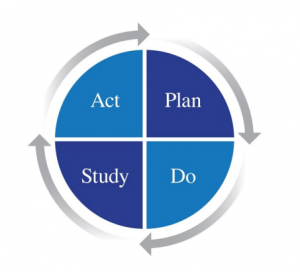
Most leaders want to be more successful than they were yesterday and are always searching for ways to improve. Some organizations exceed results year after year. Others can’t seem to sustain. How is it that some organizations do improvement so well where others falter? To answer this, we look to leaders who take the time to identify the areas where execution should be better and focus on those improvements.
ADAPT A CONTINUOUS IMPROVEMENT MINDSET
“Every organization on earth has room for improvement. One of the biggest challenges is to embrace this fact and adopt a continuous improvement mindset,” admits Greg Gibson, Superintendent of Schertz-Cibolo-Universal City Independent School District (SCUC), a district that serves 16,000 students in Texas.
In Greg Gibson’s feature article in the March issue of School Administrator, he reveals how he encourages a systematic approach to improvement in a large school district. Gibson, who has been involved with the Malcolm Baldrige National Quality Award program for over 15 years, shares how that experience has helped him lead SCUC more efficiently and effectively.
“I love using the Baldrige framework for several reasons, but primarily because it is based on a focus on improvement. No matter where you start or where you wind up, room for improvement always exists.”
Gibson and his team just completed their fourth cycle of improvement in eight years. His goal is to make the process of process improvement ingrained in the culture, so that it is sustained even after he is gone. He wants it to be second-nature for every employee.
What has this approach taught Greg over the years?
QUALITY IMPROVEMENT TAKES TIME
“I cannot emphasize enough that this is a long-term approach, particularly because the public school arena is so susceptible to quick fixes and ‘cure-all’ programs. This work is different. We take a long-term approach with deep integration of an improvement mindset.”
He has also learned to pay closer attention to the entire workforce (not just teachers). He treats employees like internal customers, serving them with the same commitment to excellence as the customers he serves in his community (parents and students).
Gibson also emphasizes how important it is to create clear key measures. This means his team must reflect and take a narrow focus on priorities.
Patience and hard work are paying off for Gibson’s team.
“Every day, I am amazed at the number of cycles of improvement occurring throughout the school district.”
CYCLES OF IMPROVEMENT IN THE CLASSROOM
The award-winning School District of Menomonee Falls (SDMF) in Wisconsin uses improvement cycles in the classroom to help students to take a proactive learning approach.
“In its simplest form, teams work together to test ideas to solve defined problems that stand between students and their learning goals,” explains Corey Golla, Superintendent of SDMF, in the March issue of School Administrator.
SDMF trains teachers to use an 8-step process that embeds the principles of continuous improvement in their classroom. The last four steps in this process are called the PDSA cycle: Plan. Do. Study. Act. This problem-solving process helps each system within an organization function as effectively as possible.

Each classroom PDSA cycle takes only 15 days to complete, and both the students and the teachers benefit. “The improvement learning cycles build student and teacher reflection into the classroom routine. As a team, they identify what worked well in the process and where they could improve in the next cycle,” says Golla.
Creating a district of master problem solvers doesn’t happen overnight. Success depends on engaging everyone in the work. PDSA cycles can be adapted and applied to any system in an organization.
HOW THE PDSA CYCLE WORKS
PDSA is designed to run in cycles, which compliments the pressure for continuous change that organizations feel today. In each PDSA cycle, the team studies results to make plans for the next round of action. PDSA allows us to test the viability of our improvement ideas before we implement them across the organization.
Stage 1: Plan. Identify the Problem.
- What are you trying to accomplish?
- How will you know if the change is an improvement?
Stage 2: Do. Implement the Action Plan.
- Test the change on a small scale, to discover and mediate any movement in the “wrong” direction quickly.
- During subsequent cycles of PDSA, test the change on a larger scale across multiple levels to determine its effectiveness system-wide.
Stage 3: Study. Analyze the Information.
- Determine if the change is an improvement, or if it creates additional problems.
- Document what has been learned from the test and decide if the change should be adapted, adopted, or abandoned.
Stage 4: Act. What Changes Should be Made?
- Can the solution tested be implemented across a larger group for testing?
- Should the plan be modified and tested again?
Other Process Improvement Approaches
Other process improvement tools include DMAIC (Define, Measure, Analyze, Improve, Control) and Carnegie Foundation’s Six Core Principles for Improvement. Previously, Dr. Pat Greco and Corey Golla provided us with the top 10 strategies for implementing, sustaining, and seeing results from continuous improvement.
Sustaining better results year after year requires dedication to continuous improvement cycles and using what we have learned to make a better decision on behalf of the organization.
When is the last time you analyzed your systems and processes to identify opportunities for improvement? If you haven’t established a system for documenting and reviewing processes at your organization, consider developing a plan to start. Adapting a continuous improvement mindset is key to your organization’s success.
